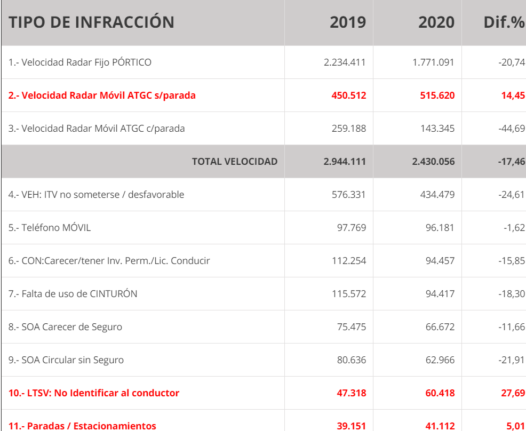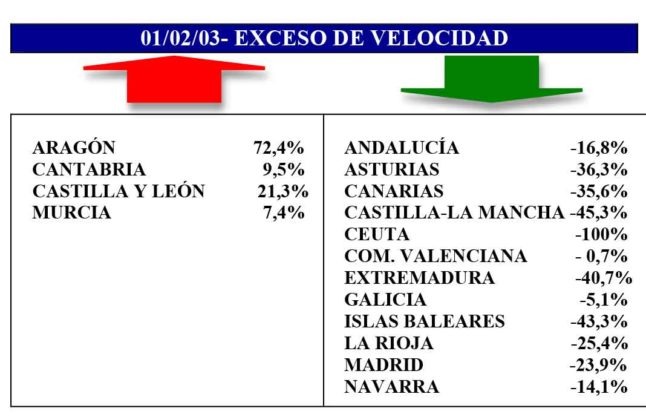[ad_1]
Believe it or not, Spain’s annual traffic fines total of 3.87 million in 2020 still represented a drop of 17 percent in fines compared to 2019’s figures (4.6 million fines).
The average drop in road traffic of 25 percent over the course of the first year of the Covid-19 pandemic has meant fewer fines were handed out, but many of the usual driving offences persisted.
A new study by the European Automotive Association (AEA) reveals just this.
Speeding continued to be the main reason for Spain’s Directorate General of Traffic (DGT) to hand out fines in 2020, with 1.77 million speeding fines handed out after drivers were caught by fixed speed cameras.
In second place with more than 515,000 recorded traffic penalties were another type of speed camera – mobile ones (radar móvil) which Guardia Civil officers usually carry with them in their vehicles whilst monitoring passing traffic. Offenders caught with these speed measuring devices actually increased by 65,000 in 2020 compared to 2019.
The third most common reason for fines being handed out by the DGT was using a vehicle that has not passed its roadworthiness test, or for it to be rejected, representing almost 435,000 fines in 2020.
Fines for using a mobile phone while driving stacked up to 96,181 last year, which also happens to be one of the driving offences which the DGT has started clamping down on with tougher penalties.
READ MORE:
Driving without a licence (94,457 fines) and not wearing a seatbelt (94,417) completed the list of main driving offences which resulted in fines in Spain in 2020.
The AEA highlighted that fines for driving under the influence of alcohol or drugs dropped by 55 and 49 percent respectively in 2020.
Speeding incidents in which Guardia Civil officers had to apprehend the drivers due to the excessive speed at which they were driving also fell by 44 percent, but negligent behaviour at the wheel increased slightly (2.6 percent), as did the rate at which motorcyclists were caught not using a helmet (17 percent).

“We are concerned that driving offenses relating to pedestrians (+15.5 percent) and cyclists (+ 66.5 percent) have increased very significantly, which is why we believe it is very necessary and urgent to launch campaigns aimed at the protection of these vulnerable road users,” AEA also stressed.
One point that the association finds “suspicious” is the 27 percent increase in the number of fines that have doubled or tripled as a result of drivers not notifying the DGT who was at the wheel when the offence was committed.
Rather than offer a 50 percent discount for early payment, the fine amounts are increasing in many cases due to the postal service holdups and problems that have meant drivers in Spain aren’t getting notified of the fine they have to pay in the post.
There’s also the added bureaucratic issue of not being able to get an appointment (cita previa) at the DGT due to past and ongoing Covid restrictions.
READ ALSO:
In which regions of Spain were the most fines handed out?
The rate of traffic fines issued fell in all of Spain’s 17 regions and two autonomous cities except for in Aragón and Castilla y León, in which multas (fines in Spanish) actually increased by 25.6 percent and 23.5 percent respectively in 2020.
The following graph from AEA’s study shows where speeding fines have increased and fallen in Spain in 2020.

Despite this, Andalusia is where the most fines were handed out last year (858,631 fines), with recorded rises in the number of people using their mobile phone while driving, not identifying the driver as well as inconsistencies relating to driving licences.
Madrid is where the highest number of driving offences were detected based on regional road network size (143 complaints per kilomere), and the interior region of La Rioja for its rate of fines per vehicle (0.21 fines per vehicle).
On the opposite side of the spectrum, Ceuta and Melilla were where the fewest road penalties were recorded, both in absolute numbers (8,372 fines) and in terms of vehicle numbers (0.06 fines per vehicle).
Castilla y León and Extremadura were the regions with the fewest fines per kilometre of road (11 fines/km).
[ad_2]
Source link